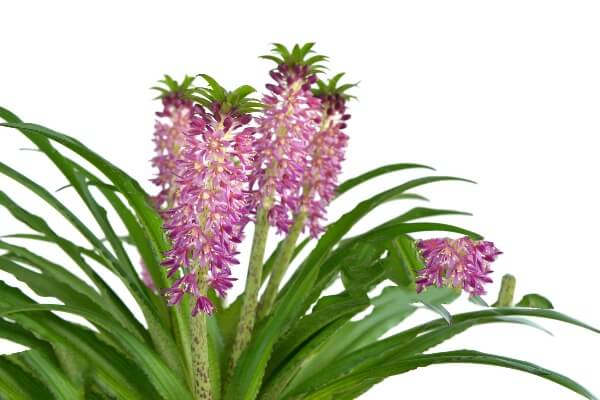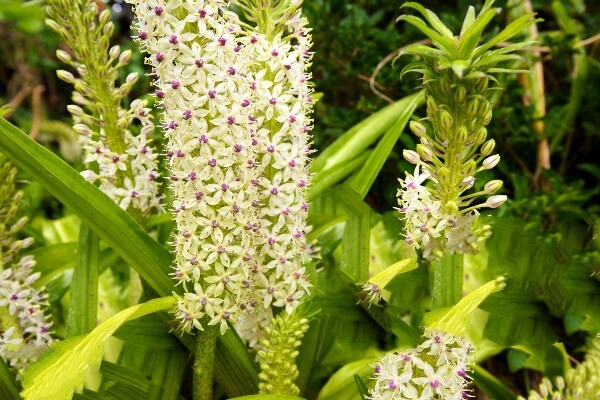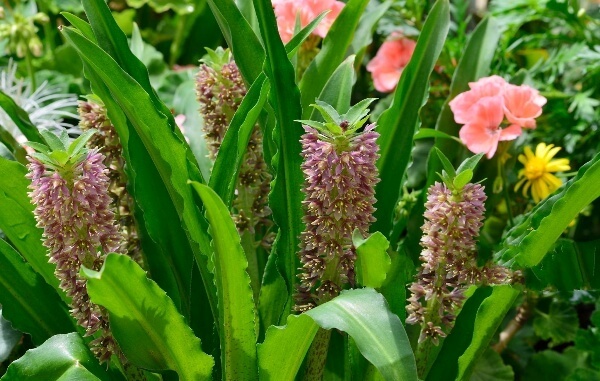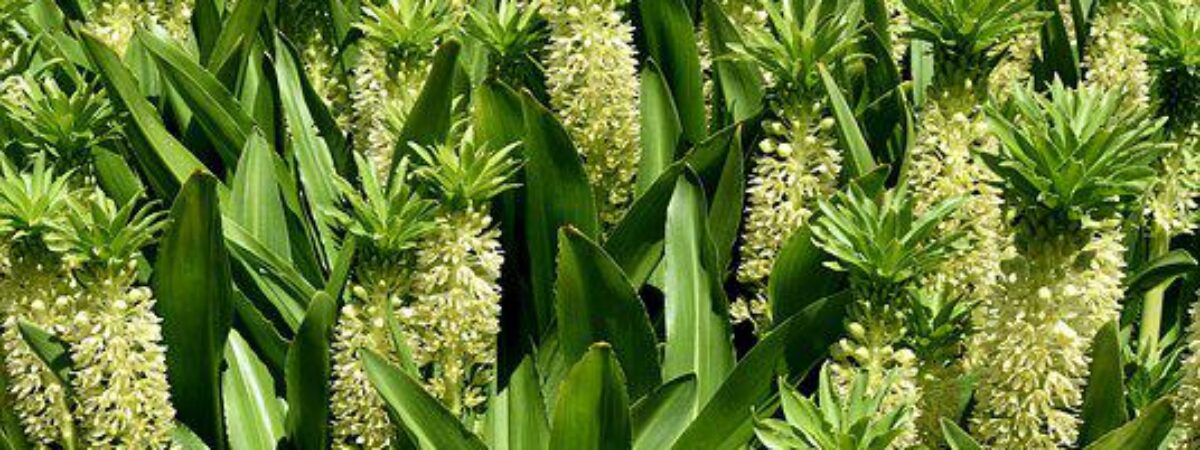Pineapple lily, scientifically known as the Eucomis are miniature floral representations of the tropical fruit. It got its name as the pineapple Lily plant for its strange, tufted bloom that appears on top of a strong, upright stem that resembles the pineapple.
It’s an easy-to-grow bulb that requires minimum maintenance, and flowers from late summer to early autumn. The pineapple lily is a perfect flowering plant for adding an exotic touch to sunny borders or sheltered gardens. These beautiful-looking plants also make a great feature plant in containers.
So let’s learn about the growing and caring guide of the pineapple Lily plant to make your garden more beautiful and to make your neighbor stop and look twice
The flowers of the pineapple lilies generally comprise many tiny little flowers that are clustered together in the shape of cones in shades of variant colors like white, cream, or flecked with violet. Click To TweetPlant overview
The water lily is an annual or rarely perennial plant that is extremely frost tender. This plant is slightly bizarre and grows up to a height of 12 to 15 inches tall.
It belongs to the genius Eucomis and it includes a wide range of tropical plants that are native to warm moist regions of the world.
Water lilies generally possess large flower heads that resemble the pineapples flanked with the green bracts.
You might be surprised to know that the pineapple lilies are actually related to the asparagus belonging to the lily family.
The flowers of the pineapple lilies generally comprise many tiny little flowers that are clustered together in the shape of cones in shades of variant colors like white, cream, or flecked with violet.
The leaves of this plant are pointed, spear-like with a flowering stem that rises above the plant.
Some of the varieties of this flower generate a faint, unpleasant smell.

Varieties of pineapple lilies to grow
Eucomis autumnalis
This variety of pineapple lillies produces a long thin flower spike topped with a small rosette of leaves.
Eucomis comosa ‘Sparkling Burgundy’
The Eucomis comosa sparkling burgundy is a popular variety of water lily that has reddish-purple, strappy leaves, from which purple-tinged flowers are borne on an erect, purple stem.
Eucomis bicolor
Eucomis bicolor is a two-tone variety of water lilies. It bears pale green flowers with a maroon edging. The RHS has given this flower, the Award of Garden Merit
Eucomis comosa
The Eucomis comosa is another tall variety of water lilies that grows up to the height of 75cm, with large leaves and a slightly wavy edge.
Eucomis pallidiflora
Eucomis pallidiflora is one of the varieties of water lilies and is also known as the giant pineapple lily. It also has won an RHS Award of Garden Merit like the Eucomis bicolor.
Where to plant pineapple lilies?
Being a tender tropical plant, pineapple lilies need plenty of suns. So it is recommended to choose the brightest, warmest spot by adding extra grit to the soil to make sure it’s really well-drained, whether you’re planting in a border or a container.
How to grow pineapple lilies?
Growing pineapple lilies are quite easy. They generally grow from the bulbs. Usually, these interesting bulbs don’t bloom for a year and start out as a rosette. Then, it produces pineapple-like flowers between July to August once a year.
You can start planting them in pots during the froast and then you can transplant them outdoors once the danger of froast had passed.
To grow the pineapple lilies in your garden, plant the bulbs of it in prepared soil that has a well drainage system. You also can add compost or leaf litter to increase the nutrient content and tilth of the soil.
So dig holes of 6 to 12 inches deep, and space them of 6 inches. Plant the bulbs. Put then in the full sun of spring.
Move the container outside when the temperature drops in spring.

Caring guide of pineapple Lily
Although pineapple lilies look like an exotic and fussy plant, it is very easy to take care of. In warm weather, if it is taken proper care of the plant, it takes a while for the foliage to emerge.
The proper care of a pineapple Lily includes
Light
Pineapple lilies thrive and bloom well in full sun. However, it requires some afternoon shade to prevent the foliage from browning due to strong sunlight.
Pineapple Lily can be propagated by collecting the seeds or removing the offsets. But it is also can be propagated by taking leaf cuttings. Click To TweetWater
Water is rarely required for the pineapple Lily plant as it is a tropical plant. But it is required to water the plant when the surface of the soil is dry.
But don’t water the plant in the fall, as it is required to keep the bulbs dry during the winter.
Soil
Although pineapple lilies have a lush and tropical appearance, they are not the plants that grow in the jungle. So it requires Rocky soil to grow.
Cactus or orchid potting mix soil is the perfect soil for the pineapple Lily plant. But it is always recommended the soil be well-draining they drain well.
Temperature
As we discussed earlier, the pineapple lilies don’t grow well in the cool weather. It requires a hot climate to grow and bloom well.
So it requires a temperature over 65 degrees Fahrenheit. So if you are living north of zone 7, it is required to dig your bulbs inside the soil during the fall and store them inside.
Humidity
The water lily can tolerate all types of humidity, as long as the soil is not soggy itself.
Fertilizer
Fertilizer is often required for the plant for healthy growth and better bloom. Plants that are fertilized are more prone to produce offsets A balanced flower fertilizer every two weeks can help pineapple lilies to grow larger and more vigorous. For the quantity, follow the instructions on the product label

How to propagate pineapple lilies?
Pineapple Lily can be propagated by collecting the seeds or removing the offsets. But it is also can be propagated by taking leaf cuttings.
Cuttings must be taken during the spring it summer allows them to form new bulbs. If you are taking the cuttings late in the season, they aren’t going to produce bulbs and they will end up in the rotted leaves.
Propagation of the water lily is quite easy. The steps of the propagation are given below.
- Remove a healthy green leaf from the bulb at the base of its stalk.
- Make a horizontal cut across the leaf with a scissor or knife.
- Keep the cuttings to the side for an hour and allow them to dry.
- Before putting the leaf section into the favorite rooting medium dust the cutting with a rooting hormone.
- Put the cuttings into the prepared soil. Cover the cuttings with a plastic bag in order to keep them away from drying out and to mist frequently.
- Remove the bag often to check the moisture content.
- Moistened the soil and the set plant into the bright area which is protected from direct sun but gets plenty of sunlight.
- You can find that the leaf-cutting up produces the bulbs along the edge of the cut after some days.
Common pests and diseases
You may face various problems that are related to the pineapple lily plant. Besides, they are very prone to different pests and diseases.
If your plants are suffering from poor flowering, it can be caused by the getting too much shade, and letting it dry too often. So to avoid this problem put the plant in a well-draining soil where it can get bright sunlight and water the plant regularly.
Sometimes the plant is prone to winter damage. So in order to keep the plant protected from the winter damage take extra care of the plant during winter. So bring the plant indoors or cover the outdoor bulbs with a thick layer of mulch during the winter.
Just like other plants, the pineapple lily is prone to the visitors like slugs, snails, and aphids. . Each of these pests enjoys eating the plants and their foliage, and threatening their ability to thrive. This can be cured by physical deterrents.
Conclusion
As you read the article this far, you might get the idea of growing and caring for the pineapple lily plant.
Pineapple lily is a beautiful plant that can add beauty to your outdoor garden. Besides it is a low-maintenance plant and very easy to take care of that adds another advantage to bringing it home.
So what are you waiting for?
As you know the growing and caring guidance of the pineapple lily plant, plant it in your garden and ad another level of beautiful appearance to your garden.






